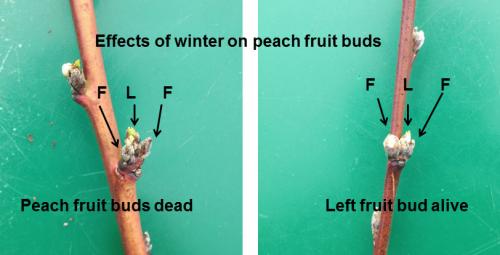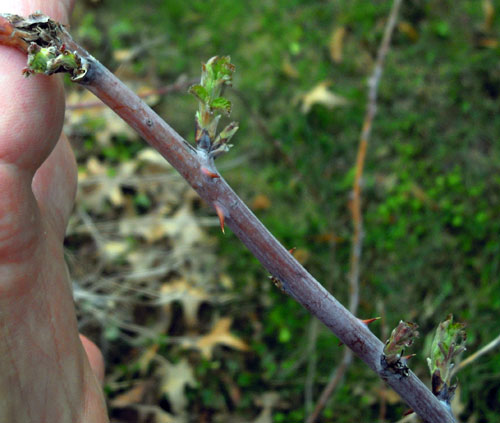Southwest Michigan fruit regional report – April 22, 2014
With warm temperatures, fruit buds are beginning to burst, exposing leaves and flowers.
Weather
April has been seasonal and the highs have been in the 50s and 60s and lows near freezing or below. Snow on Tuesday, April 15, and cold temperatures on Wednesday, April 16, with lows in the low 20s and below quickly gave way to warmer temperature over the weekend with highs into the 70s. This caused some rapid movement of fruit buds.
After the warm weekend, most perennial plants are at swollen bud or past bud break. Soils are drying and some fieldwork has begun. Comparing the growing degree days (GDD) for the last five years at the Southwest Michigan Research and Extension Center (SWMREC) shows that we are in the middle with totals cooler than 2010 and 2012, but warmer than 2009 and 2013.
Southwest Michigan GDD summary from Jan. 1 to April 20
|
Station |
GDD 42 F |
GDD 45 F |
GDD 50 F |
|
Benton Harbor (SWMREC) |
119 |
94 |
60 |
|
Fennville (TNRC) |
91 |
69 |
39 |
|
Average for the region |
116 |
91 |
57 |
Growers can check the GDDs for other Southwest Michigan Enviro-weather stations at www.enviroweather.msu.edu.
Tree fruit
Stone fruit buds are close to bursting. Some injury to sweet cherries and pluots was reported form the April 16 freeze. These two crops were the most advanced in growth and most susceptible to cold. Many fruit crops will be hurt by temperatures in the lower 20s with severe damage if the temperature drops below 20 degrees Fahrenheit. We are into the normal spring frost freeze season as fruit buds have developed slowly. Michigan State University Extension has developed a picture guide of critical spring temperatures in tree fruit.
Growers are continuing their peach pruning. Examine last year’s growth for evidence of San Jose scale infestations. Growers have applied copper to stone fruits and apples. Early season oil and insecticide sprays for San Jose scale, mites and aphids are a good option if weather permits. Oil sprays should not be applied if there is a danger of a freeze in the following two days.
Apricot buds are at red calyx.
Peach fruit buds are generally at green calyx. Fruit buds killed by winter low temperatures are dropping now. It is now becoming easier to assess crop potential. Copper applications can suppress bacterial spot by reducing bacterial populations that damage leaves and fruit after bloom. See “Management of bacterial spot on peaches and nectarines” for more details. Be careful to not over-apply copper. Reapplication of copper is not needed until after significant amounts have been removed by rainfall.

Live peach buds are now noticeably growing as dead buds dry and shrivel. Photo credit: Bill Shane, MSU Extension
In cherries, sweet cherry buds are at green tip to early bud burst. If you still need to apply copper to reduce bacterial canker, bud burst is the end of the early season copper spray window.
Tart cherry buds are at green tip in Berrien and Van Buren counties. Montmorency cherries are much more tolerant of copper, so growers still have time to apply this material.
Japanese plum fruit buds are at late bud swell and European plum fruit buds are at green tip. Low rate copper sprays now will help suppress bacterial spot symptoms after bloom. Black knot infections can occur from first green buds until active shoot growth slows down in early to mid-summer. The most important time for fungicide treatment for this disease is from first color on flower buds until approximately three weeks later.
Apples range from 0.25 inch to early tight cluster in Berrien County. Apple scab ascospores were caught during rains beginning April 17. This rain was a scab infection period throughout the southwest Michigan area. Copper applications should not be used for fresh market apples once the flower buds are exposed (e.g., tight cluster) to avoid phytotoxicity and russetting of the fruit finish.
The most important period for control of powdery mildew starts at pink and continues until terminal bud set. Patrol orchards for infested terminal growth from last year’s powdery mildew infections and cut off these infections when seen. At the same time, look for last year’s fire blight infection and remove affected branches that are greater than 0.5 inch in diameter.
Pear buds have swollen markedly over the past week and are at the pre-bud burst stage. Pear scab control is needed as susceptible green tissue emerges. Pear psylla management begins at the white bud stage.
Small fruit
Grape GDDs are base 50 F and heat accumulation starts April 1.
Southwest Michigan GDD summary for grapes from April 1 to April 20
|
Station |
GDD 50 F |
|
Benton Harbor (SWMREC) |
62 |
|
Lawton |
64 |
|
Fennville (TNRC) |
40 |
|
Average for the region |
59 |
Growth in grapes is proceeding slowly. Some bud scales have cracked, but many are still dormant. There is still time for dormant sprays in grapes; an application of lime sulfur, sulfur or copper to reduce inoculum of phomopsis, anthracnose, black rot powdery and downy mildew. Check the 2014 Michigan Fruit Management Guide (E-154) to determine whether or not the grape varieties you are spraying are sensitive to copper or sulfur.
As buds develop, climbing cutworms and grape flea beetles will be the insect pests to watch out for. Growers have generally finished pruning and tying and are applying pre-emergence herbicides.
Blueberry flower buds are swollen, but there is very little green tip showing so far in the leaf buds. Green tissue is out in Berrien County. Many fields are showing a light fruit bud set with a lot of dead and weak wood as a result of last year’s heavy crop.
As leaf tissue emerges, mummy berry infections are possible. Growers should be scouting for mummy berry apothecia, also called mushrooms or trumpets. Mummies have been found in wet sites, but most are small at about 1 millimeter; some are approaching 2 millimeters, when spore release begins.
Spores are generally released under dry conditions, not during rains. Free water is required for the spores to germinate and begin infection. See the article “Understanding mummy berry shoot strikes” for more information on the infection conditions necessary for mummy berry shoot strike, including temperature and wetness requirements. Freezes increase the susceptibility of tissues to infection, so protectant materials should be applied before freezes while systemic materials should be applied quickly after a freeze.
In strawberries, new leaves are emerging from the crown. The flower trusses are not yet visible in the ground. Strawberries in the high tunnels have visible flower trusses and open flowers.
Bramble buds are moving with 0.25 to 0.5 inch of green tissue out. Winter damage to overwintering canes is severe in many plantings. New primocanes are beginning to emerge from the ground. Fall bearing raspberries have been mowed. Lime sulfur treatments for anthracnose are being applied. High-tunnel raspberries are more advanced than raspberries in the field with new growth of 2-6 inches.

Black raspberries seem less affected by the winter cold. These new shoots are about 0.5 inch long. Photo credit: Mark Longstroth, MSU Extension
Upcoming meetings
Our next Monday fruit IPM meeting is April 28 at Fruit Acres Farms, 3452 Friday Rd, Coloma, MI at 5 p.m. Michigan pesticide applicator recertification credits will be given for these meetings.



 Print
Print Email
Email



